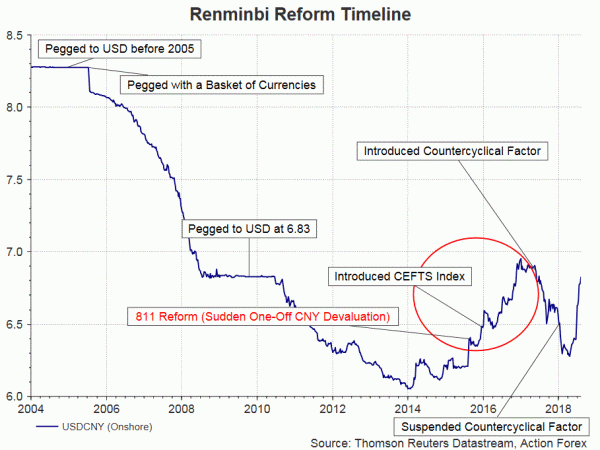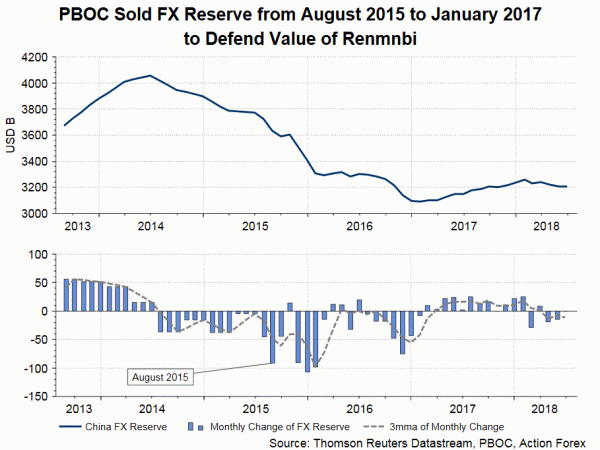PBOC announced last Friday to impose 20% reserve requirement ratio (RRR) on onshore (CNY) FX forward transactions. Despite the central bank’s denial, the move is obviously to moderate recent sharp depreciation of renminbi. Such measure was implemented on October 15, 2015, before removal on September 11, 2017, in an attempt to rescue the massive selloff of renminbi. Back in 2015, PBOC’s renminbi reform on August 11 included an abrupt announcement of one-off devaluation of renminibi by +2% against US dollar. Such move had damaged market confidence over PBOC and the currency. Since then, the central bank has included adjustment of reserve requirement on FX forward trading in its list of so-called “macro-prudential” policy, notwithstanding the underlying goal of curbing capital outflow.
“811-Reform”
On August 11, 2015, PBOC abruptly devaluated renminbi by -2%. On actual trading, CNY plunged -1.8% against USD, the biggest one-day decline since 1994. Accompanying the one-off devaluation, PBOC announced a new renminbi fixing mechanism, suggesting that the components used in setting that daily fixing rate include previous’ day’s close, FX demand and supply conditions and movement of major currencies. The market believed that the new mechanism had paved the way for renminibi to join IMF’s special drawing right (SDR). While inclusions of demand/supply conditions and movement of major currencies in the fixing mechanism might have signaled the government’s effort to make renminbi more market-oriented, the surprising devaluation had dampened market confidence on the currency and evidenced that the currency remained under manipulation to the authority despite the rhetoric of market-orientation.
Panic selling of renminbi following the “811-reform” triggered the government to adopt a series of capital control measures, including the abovementioned 20% FX reserve ratio effective from October 2015. Other capital control measures includes strengthening supervision of foreign exchange purchases by foreign-held non-resident accounts (NRA), monitoring firms’ foreign exchange buying and tightening supervision of bank clients’ foreign exchange deals. Besides capital control measures, the government also aggressively sold FX reserve in support of renminbi. US$630B of FX reserve was evaporated from Aug-2015 to Dec-2016 and PBOC’s aggressive selling sent FX reserve below US$ 3 trillion in early 2017.
The case of 2018
Since the 811 reform, renminbi had fallen against US dollar before reaching a bottom at January 3, 2017. The currency pair slumped about 10% over the 16-month period. The recent renminbi selloff has been driven mainly by market pressure as a result of the intensification of US-China conflict. Renminbi has plunged over -7% against the greenback in just 2 months. The pace of the depreciation should justify PBOC’s concern over capital outflow. Given our view that the trade conflict would continue for some time, risk is skewed to the downside for renminbi. Therefore, we expect more capital control measures to be announced following the re-introduction of the FX reserve requirement. The FX reserve in August (to be released this week) would be closely watched. We will not be surprised to see a drop in FX reserve as the government might have intervened to defend the renminbi.















